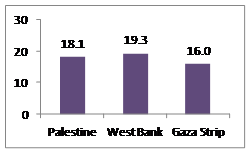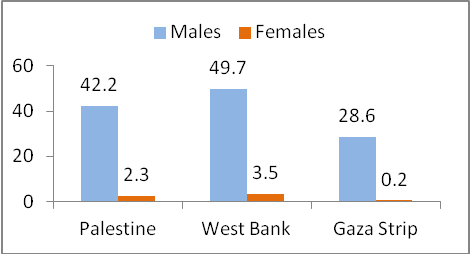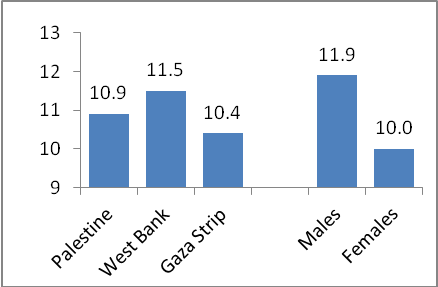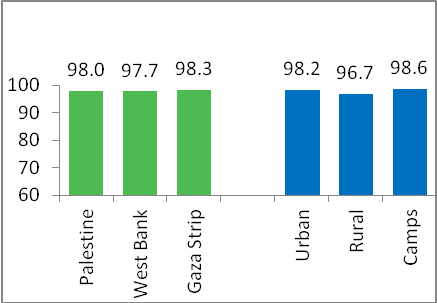The Palestinian Central Bureau of Statistics (PCBS) and the Ministry of Health (MOH) Issue a Press Release on the Occasion of International Health Day 07/04/2014
World Health Day 2014
WHO identified a major subject for World Health Day this year which is "vector-borne diseases." The purpose of this year's campaign is to highlight some of the most commonly known vectors – such as mosquitoes, sandflies, bugs, ticks and snails – responsible for transmitting a wide range of parasites and pathogens that attack humans or animals. for example, Malaria, Dengue Fever, Japanese encephalitis, Lymphatic disease,
Schistosomiasis, Yellow fever, Leishmaniasis, Chagas disease, Chikungunya, Crimean-Congo hemorrhagic fever, Human African trypanosomiasis, Onchocerciasis
Vector-Borne Diseases in Palestine
Due to the efforts of the Palestinian Ministry of Health and it's preventive procedures; Palestine is completely free of all vector-borne diseases listed above with the exception of the disease leishmaniasis, which still recorded injuries in the West Bank , while the Gaza Strip free of it as a result of the different nature of the environment.
In the year 2012 recorded 228 cases of leishmaniasis Leather in the West Bank at a rate of infection of 8.5 per hundred thousand population, and recorded about 80% of cases in Jericho and Al-aghwar governorate, Tubas, and Qalqilya. Also recorded 8 cases of cytoplasmic leishmaniasis in three governorates: (4 in Ramallah and Al-Bireh 0.3 in Hebron, and one in Nablus ) , and the rate of infection of 0.3 per hundred thousand people. The Ministry of Health, especially the Departments of Environmental Health and Preventive Medicine is doing great efforts in the fight against this disease and in the treatment of the patients .
Secondary Health Care
There were 79 government and non-governmental hospitals in Palestine in 2012 with a capacity of 5,487 beds: 25 MOH hospitals with a capacity of 2,979 beds which represent 54.3% of the total beds, and 54 non-governmental hospitals with a capacity of 2,508 beds which represent 45.7% of the total hospital beds .
Primary Health Care
There were 750 clinics and primary care centers in 2012, including 603 clinics in the West Bank and 147 in the Gaza Strip.
While the MOH centers were 460 which represent 61.3% of the total primary health centers in Palestine.
Workers in Health Sector
A total of 8,810 physicians were registered in Palestine in 2012. The average number of physicians per 1,000 of population was 2.2: 2.3 in the West Bank and 2.2 in the Gaza Strip.
There were 11,633 nurses registered in Palestine in 2012. The average number of nurses per 1,000 of population was 2.7: 2.2 per 1000 in the West Bank and 3.4 in the Gaza Strip.
Public Health
Chronic Diseases
Percentage of Persons 18 Years and Over Who Reported at Least One Chronic Disease by Region, 2010

Percentage of Persons Aged 18 Years and Over Reported as Smokers by Sex and Region, 2010

Under-five Mortality Rate
In 2010, the under-five mortality rate in Palestine varied by region and sex. In the West Bank the rate was 21.0 per 1,000 live births. It was highest in the Gaza Strip at 26.8 per 1,000 live births. Significant differences were noted in under-five mortality rates between males and females with 26.6 per 1000 live births for male children compared with 20.1 per 1000 live birth for female children.
The infant mortality rate in Palestine was 18.9 per 1000 live births: 18.1 per 1000 live births in the West Bank and 20.1 per 1000 live births in the Gaza Strip.
Child Health
Malnutrition in Children Under Five Years
Male children under five years suffer from moderate and severe stunting more than females in the same age group: the rate was 11.9% for males and 10.0% for females. The percentage was 11.5% in the West Bank and 10.4% in the Gaza Strip.
Percentage of Children Under Five Years Who are Severely or Moderately Stunted by Region and Sex, 2010

Breastfeeding
In 2010, 95.8% of children aged 0-23 months in Palestine were breastfed: 95.4% in the West Bank and 96.4% in the Gaza Strip. The data showed that 61.5% of children in that age group were breastfed within the first hour of birth: this percentage was higher in the Gaza Strip (66.0%) than in the West Bank (58.3%). The percentage of children ever breastfed also varied by locality: the lowest percentage was observed among children in rural districts (58.0%) compared with 62.1% of urban children and 63.3% of children in camps.
Reproductive Health
Use of family planning methods
Currently married women aged 15-49 years in rural areas used contraceptives more than women in urban areas and camps: 53.7% among women in rural areas, 52.5% in urban areas and 50.0% in camps.
Data show that 52.5% of currently married women aged 15-49 years in Palestine used contraceptives: 55.1% in the West Bank and 48.2% in the Gaza Strip.
The most common method of contraception was an IUD, used by 26.3% of married women in Palestine in 2010. The second most common method was the contraceptive pill, used by 7.0% of married women.
In Palestine in 2010, 15.6% of married women aged 15-49 years in Palestine had an unmet need for family planning methods: 10.4% to space children out and 5.3% to prevent pregnancy. Married women aged 15-49 years in the Gaza Strip had a greater unmet need for family planning methods than women in the West Bank: the figures were 17.0% and 14.9% respectively.
Palestinian women aged 15-49 years in rural areas visited qualified staff the least during their previous pregnancy. In 2010, the percentage of women who visited qualified staff (four visits at least) in rural areas was 89.9% compared with 94.6% in urban areas and 96.5% of women in camps.
Health Care During Delivery
In 2010, 98.0% of births in Palestine occurred at a health facility: 97.7% in the West Bank and 98.3% in the Gaza Strip. Data showed that the rate was lowest in rural areas at 96.7% compared with 98.2% of urban women. The highest percentage was 98.6% among women in camps. The data indicate that 16.7% of births in Palestine were by Caesarean section.
Percentage of Births at Health Facilities by Region and Locality, 2010

 عربي
عربي